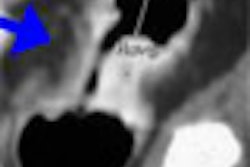Early indications suggest that CT angiography (CTA) may become a panacea for the detection and diagnosis of ischemic heart disease, but one recently released study shows that trustworthy evidence to that end is lacking.
An analysis of clinical studies to date found that CTA is overall less accurate than conventional or invasive angiography, but may be useful in selected patient populations. While CTA eliminates the need for an interarterial catheter, it is associated with similar -- if not slightly higher -- exposure to radiation.
Dr. David E. Kandzari, associate professor of interventional cardiology and genomic sciences at the Duke Clinical Research Institute in Durham, NC, presented his analysis of cardiac CT angiography at Stanford University's International Symposium on Multidetector-Row CT in San Francisco in June.
He noted in his presentation that there is "no evidence that CTA can replace x-ray angiography prior to revascularization; there is no evidence to date that it can provide a useful adjunct to x-ray angiography for the native coronary evaluation; and there is no empirical data related to the availability, convenience or resource implications."
The overall utilization of CT angiography is "exceeding the evidence in routine clinical practice (and) substantiates the need for appropriate criteria as we await further trials that will clarify the role in treatment decision-making," Kandzari added.
Base research
Proof of concept studies often use, in Kandzari's words, "clinically obvious cases for initial evaluation of the diagnostic performance. Intuitively, this overestimates the performance in clinically relevant populations." He added the point is "particularly relevant" when one considers the overall prevalence of ischemic heart disease in the CTA studies is 54%, while in the U.S. adult population, the prevalence of ischemic heart disease is approximately 7%.
The Duke Center for Evidence-based Practices presented its research on the clinical utility of noninvasive CTA for assessing coronary artery disease to the Centers for Medicare and Medicaid Services (CMS) in May. The study was designed to identify key articles and literature that would support the use of CTA and MR angiography (MRA) for coronary imaging. The work covered 114 primary articles and 123 reviews.
The criteria for Duke's study were that all the information would come from peer-reviewed published literature and no abstracts or presentations, and that direct comparisons of CTA with invasive x-ray conventional angiography be included. Examinations limited to the native coronary arteries, excluding congenital coronary anomalies, coronary stents, and bypass grafts, would be used as well.
The goal was to assess the quality of the studies and determine if they were prospective in their assessments, whether they included consecutive patients or the imaging technique was standardized, whether variables were reported based on outcomes, and if the patients were representative of Medicare beneficiaries.
Statistical analysis
The research found 29 multirow CTA studies, six of which analyzed 64-row CTA on fewer than 400 patients in total. Those studies reported sensitivity ranging from 73% to 99% and specificity between 90% and 97%, and had what Kandzari described as "limitations." For example, up to 12% of coronary segments were excluded, and the average age of the patients was 60 years, when the prevalence of coronary artery disease is "quite high."
Only one study had subjects with a mean age greater than 65 years, and to date there has been no subgroup analysis by age.
One study from William Beaumont Hospital in Royal Oak, MI, (published in the August 2005 issue of the Journal of the American College of Cardiology) reviewed the role of 64-row CTA in 70 patients. It found that 88% of the patients could be analyzed and, by coronary segmental analysis, the sensitivity was 86% with a specificity of 95%. In his review of the study, Kandzari maintained that there were "challenges" with older patients having extensive calcification and obese patients with elevated body mass and higher heart rates. Calcification, which expectedly is more common in older individuals, decreases test specificity (JACC, August 2, 2005, Vol. 46:3, pp. 552-557).
A 16-row CTA study highlighted by Kandzari reviewed 149 patients. One-quarter of the coronary segments were of poor quality and approximately 25% of the patients had artifacts from movement or calcifications. "Therefore, by coronary segmental analysis, the sensitivity was quite low -- only 30% -- but the specificity was 91%," he noted (European Heart Journal, October 2005, Vol. 26:19, pp. 1987-1992).
"The ultimate goal is to improve the outcome of our patients, but the value of diagnostic tests -- for example, CT angiography -- will depend on the ability of the test data to alter a physician's management," Kandzari said. "Therefore, I think specifically relevant to CT angiography, tests that do not change management much -- or at least today have not improved the change management much -- will be considerably harder to value."
By Wayne Forrest
AuntMinnie.com staff writer
August 1, 2006
Related Reading
Cardiac CTA a no-go zone for some, July 17, 2006
Less radiation dose exposure in cardiac CT is possible, July 6, 2006
Dual-source imaging promises better CT scanning, June 15, 2006
CT angiography detects significant coronary lesions prior to valve surgery, June 8, 2006
Concentrated iodine permits lower volumes in cardiac CTA, May 22, 2006
Copyright © 2006 AuntMinnie.com




















